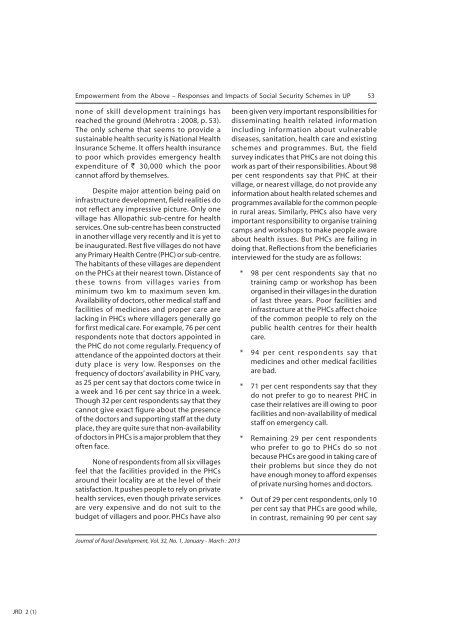January - March 2013 - National Institute of Rural Development
January - March 2013 - National Institute of Rural Development
January - March 2013 - National Institute of Rural Development
- No tags were found...
You also want an ePaper? Increase the reach of your titles
YUMPU automatically turns print PDFs into web optimized ePapers that Google loves.
Empowerment from the Above – Responses and Impacts <strong>of</strong> Social Security Schemes in UP 53none <strong>of</strong> skill development trainings hasreached the ground (Mehrotra : 2008, p. 53).The only scheme that seems to provide asustainable health security is <strong>National</strong> HealthInsurance Scheme. It <strong>of</strong>fers health insuranceto poor which provides emergency healthexpenditure <strong>of</strong> ` 30,000 which the poorcannot afford by themselves.Despite major attention being paid oninfrastructure development, field realities donot reflect any impressive picture. Only onevillage has Allopathic sub-centre for healthservices. One sub-centre has been constructedin another village very recently and it is yet tobe inaugurated. Rest five villages do not haveany Primary Health Centre (PHC) or sub-centre.The habitants <strong>of</strong> these villages are dependenton the PHCs at their nearest town. Distance <strong>of</strong>these towns from villages varies fromminimum two km to maximum seven km.Availability <strong>of</strong> doctors, other medical staff andfacilities <strong>of</strong> medicines and proper care arelacking in PHCs where villagers generally g<strong>of</strong>or first medical care. For example, 76 per centrespondents note that doctors appointed inthe PHC do not come regularly. Frequency <strong>of</strong>attendance <strong>of</strong> the appointed doctors at theirduty place is very low. Responses on thefrequency <strong>of</strong> doctors’ availability in PHC vary,as 25 per cent say that doctors come twice ina week and 16 per cent say thrice in a week.Though 32 per cent respondents say that theycannot give exact figure about the presence<strong>of</strong> the doctors and supporting staff at the dutyplace, they are quite sure that non-availability<strong>of</strong> doctors in PHCs is a major problem that they<strong>of</strong>ten face.None <strong>of</strong> respondents from all six villagesfeel that the facilities provided in the PHCsaround their locality are at the level <strong>of</strong> theirsatisfaction. It pushes people to rely on privatehealth services, even though private servicesare very expensive and do not suit to thebudget <strong>of</strong> villagers and poor. PHCs have alsobeen given very important responsibilities fordisseminating health related informationincluding information about vulnerablediseases, sanitation, health care and existingschemes and programmes. But, the fieldsurvey indicates that PHCs are not doing thiswork as part <strong>of</strong> their responsibilities. About 98per cent respondents say that PHC at theirvillage, or nearest village, do not provide anyinformation about health related schemes andprogrammes available for the common peoplein rural areas. Similarly, PHCs also have veryimportant responsibility to organise trainingcamps and workshops to make people awareabout health issues. But PHCs are failing indoing that. Reflections from the beneficiariesinterviewed for the study are as follows:* 98 per cent respondents say that notraining camp or workshop has beenorganised in their villages in the duration<strong>of</strong> last three years. Poor facilities andinfrastructure at the PHCs affect choice<strong>of</strong> the common people to rely on thepublic health centres for their healthcare.* 94 per cent respondents say thatmedicines and other medical facilitiesare bad.* 71 per cent respondents say that theydo not prefer to go to nearest PHC incase their relatives are ill owing to poorfacilities and non-availability <strong>of</strong> medicalstaff on emergency call.* Remaining 29 per cent respondentswho prefer to go to PHCs do so notbecause PHCs are good in taking care <strong>of</strong>their problems but since they do nothave enough money to afford expenses<strong>of</strong> private nursing homes and doctors.* Out <strong>of</strong> 29 per cent respondents, only 10per cent say that PHCs are good while,in contrast, remaining 90 per cent sayJournal <strong>of</strong> <strong>Rural</strong> <strong>Development</strong>, Vol. 32, No. 1, <strong>January</strong> - <strong>March</strong> : <strong>2013</strong>JRD 2 (1)
















